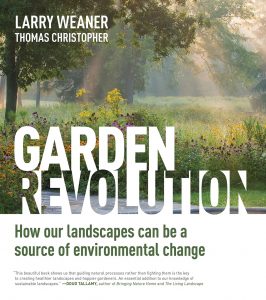Garden Revolution
Posted in From the Library on November 21 2016, by Esther Jackson
Esther Jackson is the Public Services Librarian at NYBG’s LuEsther T. Mertz Library where she manages Reference and Circulation services and oversees the Plant Information Office. She spends much of her time assisting researchers, providing instruction related to library resources, and collaborating with NYBG staff on various projects related to Garden initiatives and events.
 Timber Press has really been hitting the mark over the past few years with books related to landscape design, land management, and ecology. Planting in a Post Wild World, read as a landscape design manifesto, was my favorite recent book of this ilk, and Cultivating Chaos offered some truly breathtaking examples of “wild” plantings and garden design.
Timber Press has really been hitting the mark over the past few years with books related to landscape design, land management, and ecology. Planting in a Post Wild World, read as a landscape design manifesto, was my favorite recent book of this ilk, and Cultivating Chaos offered some truly breathtaking examples of “wild” plantings and garden design.
When I opened Garden Revolution, I expected a book like Post Wild World or Cultivating Chaos. In fact, Revolution looks at the same big questions of land management and ecology, but leads the reader on a rather different journey.
“Where are we, ecologically speaking, in both space and time?” wonder authors Larry Weaner and Thomas Christopher. This is indeed a deeply practical question in spite of the philosophical ponderings it may inspire. In many ways, this question is at the heart of the practices the authors espouse. Ecological gardening “…fulfills many of the goals promoted by the environmental activists. It turns the landscape from a consumer of resources and a polluter into a source of environmental renewal.” At every point, the reader is asked to think carefully about the land or garden that they manage in a holistic way. Beyond simply telling readers that they should be thoughtful about their localities and environment, the authors provide an immense amount of practical advice and instruction.
In some ways, Revolution reads like a textbook, full of substance and staying power. It is densely packed with an extraordinary amount of information. The text is broken into three primary sections: “The Learning Process,” “Design,” and “In the Field.” From cover to cover, Revolution offers clear and practical guidance in land management, with a design-conscious eye toward creating not only ecologically sensitive landscapes, but beautiful ones. This is an excellent book for those who are trying to be responsible land managers and are looking for some guidance and best practices. It’s also a great resource for experienced gardeners and horticulturists who are interested in keeping abreast of contemporary topics and discussions.
As gardeners, horticulturists, and home owners can attest, there is no one-size-fits-all approach to land management. Garden Revolution gives land managers the toolkit to work with land on large and small scales in order to create ecologically sensitive landscapes. For anyone who is a steward of land or interested in the topic, this is a book to find and read sooner rather than later.

